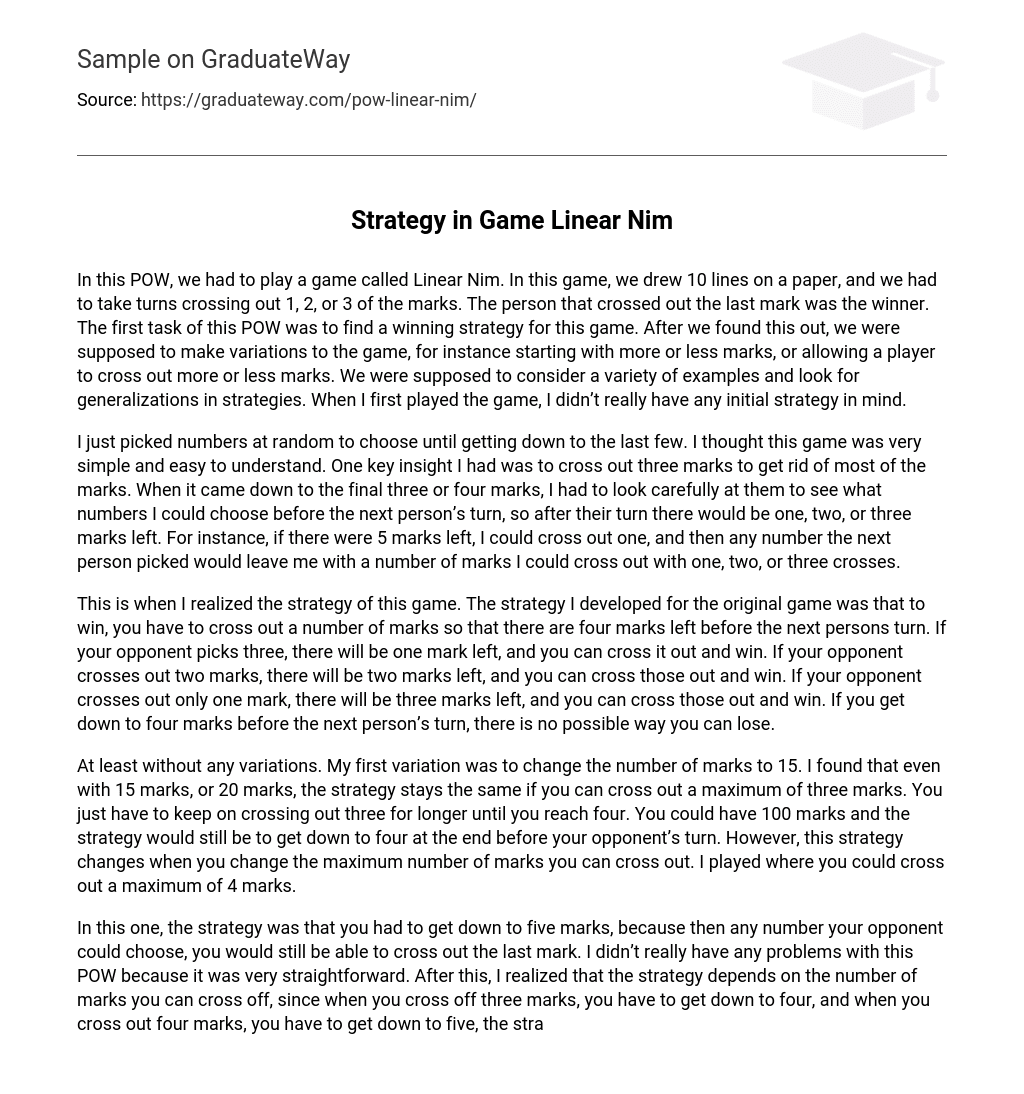In this POW, we had to play a game called Linear Nim. In this game, we drew 10 lines on a paper, and we had to take turns crossing out 1, 2, or 3 of the marks. The person that crossed out the last mark was the winner. The first task of this POW was to find a winning strategy for this game. After we found this out, we were supposed to make variations to the game, for instance starting with more or less marks, or allowing a player to cross out more or less marks. We were supposed to consider a variety of examples and look for generalizations in strategies. When I first played the game, I didn’t really have any initial strategy in mind.
I just picked numbers at random to choose until getting down to the last few. I thought this game was very simple and easy to understand. One key insight I had was to cross out three marks to get rid of most of the marks. When it came down to the final three or four marks, I had to look carefully at them to see what numbers I could choose before the next person’s turn, so after their turn there would be one, two, or three marks left. For instance, if there were 5 marks left, I could cross out one, and then any number the next person picked would leave me with a number of marks I could cross out with one, two, or three crosses.
This is when I realized the strategy of this game. The strategy I developed for the original game was that to win, you have to cross out a number of marks so that there are four marks left before the next persons turn. If your opponent picks three, there will be one mark left, and you can cross it out and win. If your opponent crosses out two marks, there will be two marks left, and you can cross those out and win. If your opponent crosses out only one mark, there will be three marks left, and you can cross those out and win. If you get down to four marks before the next person’s turn, there is no possible way you can lose.
At least without any variations. My first variation was to change the number of marks to 15. I found that even with 15 marks, or 20 marks, the strategy stays the same if you can cross out a maximum of three marks. You just have to keep on crossing out three for longer until you reach four. You could have 100 marks and the strategy would still be to get down to four at the end before your opponent’s turn. However, this strategy changes when you change the maximum number of marks you can cross out. I played where you could cross out a maximum of 4 marks.
In this one, the strategy was that you had to get down to five marks, because then any number your opponent could choose, you would still be able to cross out the last mark. I didn’t really have any problems with this POW because it was very straightforward. After this, I realized that the strategy depends on the number of marks you can cross off, since when you cross off three marks, you have to get down to four, and when you cross out four marks, you have to get down to five, the strategy could be that you have to get down to whatever your maximum number of crosses is plus 1.
I tested this generalization, playing with 6 and 7 maximum number of marks you could cross out and it always works. I realized this because if you have one more than the maximum number of marks that you can cross out left, there will always be at least one mark left for you to cross out, making it possible for you to cross out the last mark and win. After I realized this part of the strategy, I also realized that the person that goes second will always win. This is because with 10 marks, there are two sets of four, which is the number of marks you need to make your opponent lose.
If you go second, the other person will make one, two, or three marks leaving you “in control” of the remaining marks. I think I would say the difficulty of this POW would be 3 out of 10. The process was not difficult at all; it was just a little bit of a challenge to verbalize why the strategy I was using worked. I think this POW would have been better with if they explained what a generalization was, because at first I was a little bit confused about that, but soon I understood that it was a strategy you could generalize on Linear Nim no matter what variation you were using.
I was also pretty confused about why it mattered if you went first or second, but then I realized about the two sets of four. What I learned from this POW is that it is very good to test your strategy many times to make sure it works, because it might just be a onetime luck thing. You also shouldn’t assume you have the right answer, but check over every aspect of the problem to make sure you have answered everything it asked for. For this POW, I tested my strategy many times, and it worked every time.





